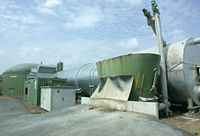
Photo from wikipedia
Abstract Field data on ammonia emission after liquid cattle manure (‘slurry’) application to grassland were statistically analysed to reveal the effect of manure and field characteristics and of weather conditions… Click to show full abstract
Abstract Field data on ammonia emission after liquid cattle manure (‘slurry’) application to grassland were statistically analysed to reveal the effect of manure and field characteristics and of weather conditions in eight consecutive periods after manure application. Logistic regression models, modelling the emission expressed as a percentage of the ammonia still present at the start of each period as the response variable, were developed separately for broadcast spreading, narrow band application (trailing shoe) and shallow injection. Wind speed, temperature, soil type, total ammoniacal nitrogen (TAN) content and dry matter content of the manure, application rate and grass height were selected as significant explanatory variables. Their effects differed for each application method and among periods. Temperature and wind speed were generally the most important drivers for emission. The fitted regression models were used to reveal seasonal trends in NH3 emission employing historical meteorological data for the years 1991–2014. The overall average emission was higher in early and midsummer than in early spring and late summer. This seasonal trend was most pronounced for broadcast spreading followed by narrow band application, and was almost absent for shallow injection. However, due to the large variation in weather conditions, emission on a particular day in early spring can be higher than on a particular day in summer. The analysis further revealed that, in a specific scenario and depending on the application technique, emission could be reduced with 20–30% by restricting manure application to favourable days, i.e. with weather conditions with minimal emission levels.
Journal Title: Atmospheric Environment
Year Published: 2018
Link to full text (if available)
Share on Social Media: Sign Up to like & get
recommendations!